Why Are Starlings a Problem?
In North America, European Starlings are undoubtedly a problem. They are an invasive species, they shouldn’t be there and they don’t form a natural part of the local ecosystem.
But here in the UK starlings are one of our native birds, declining in numbers, but still a fairly common sight in our gardens. So why do people view them as a problem?
Flocks
The primary cause of starlings unpopularity probably comes from their gregarious, sociable nature.
Starlings rarely come to the party alone, they bring a crowd. Though during the spring and early summer starlings tend to live in smaller, loose colonies come the autumn, juveniles start to form large flocks, And in winter migrants from northern and eastern Europe swell the numbers of our native starlings, arriving in huge flocks of thousands of birds.
This of course is when we get the chance to see the amazing sight of starling murmurations. If you’ve never seen one of these spectacular aerobatic displays live they are well worth seeking out.

Living in flocks has many advantages for starlings, protection from predators and winter warmth are just two. But for humans, the arrival of a whole flock of starlings can be more challenging.
Noise
Starlings are chatty, noisy birds. Personally, I enjoy their constant squabbling and squawking. But for anyone who prefers a little more tranquillity in the garden a flock of starlings is going to ruin your day.
Eating You Out of House and Home
Starlings are enthusiastic guests at our bird feeders and because they travel in groups and have evolved to feed quickly they can seem to decimate the contents of your bird feeders in record time. Leaving nothing for other birds.
They are not being greedy, it’s just what they do. But still, things can quickly start to get expensive if you don’t manage the situation.
Taking Over
Though starlings don’t defend a breeding territory, like robins, they will fight other starlings and other species for food.
They are a chunky bird, and size combined with numbers and aggression may lead you to feel that a healthy starling population could drive smaller birds out.
Poop-Tastic
If you have a starling roosting site in or near your garden droppings can certainly become a problem.
Droppings from hundreds or even thousands of birds can cause a mess or even possibly a health risk if they are fulling directly onto people or animals.
Starlings like to roost in sites with plenty of branches or ledges. So manmade structures like piers or multi-story car parks are favourites, as are large trees and groups of conifers.
The problems caused by larger flocks of starlings are short-lived though. Arriving just before Christmas in most years they usually start to disperse by February and colonies return to a more manageable size.
Starlings and Conservation
Though still, a pretty common sight in our gardens starlings in the UK are in dramatic decline. So even if from time to time, they can be challenging birds to have around, there are legal and ethical reasons to consider before we try to discourage them from our gardens or bird feeders.
Why are Starlings in Trouble?
Estimates vary, but according to RSPB studies numbers have decreased by 80% in the past 50 years. The British Trust for Ornithology reports that there are now as few as 1.6 million breeding pairs here in the UK.
For this reason, starlings are now red-listed for conservation purposes and protected under the Wildlife and Countryside Act 1981.
But why are numbers declining so sharply? Why are starlings in trouble?
Nesting Sites
Like several other bird species, starlings like to nest in cavities or holes. These could either be in mature trees or in manmade structures.
Suitable nest sites are getting more difficult to find. We are cutting down mature trees and modern construction methods mean that the cavities in eaves and soffit boards that starlings love to nest in are becoming scarce.

Starlings are very successful breeders with over 70% of eggs laid successfully fledgling. But without suitable nest sites, there’s no chance for the eggs to be laid in the first place.
Food
Like robins and blackbirds, starlings eat mainly insects and invertebrates in summer and move on to seeds and berries in the autumn and winter months. Baby starlings rely entirely on invertebrates for food.

Although they can and sometimes do fly catch, starlings mainly feed on the ground. They eat a wide range of insects but their favourite food is leatherjackets, the larvae of the crane fly.
Leatherjackets and many of the other insects favoured by starlings and their young live in short grass. So agricultural land with permanent pasture was a prime feeding ground. The dramatic decrease in permanent pasture, monoculture agriculture and the increased use of pesticides has led to a decline in invertebrate numbers of up to 75%.

With up to 75% of the starlings’ natural diet removed they, along with many other small bird species, hedgehogs and other mammals and amphibians and quite literally starving to death.
I guess this is why I’d be reluctant to turn them away from my garden, however annoying I might find them.
Starlings and The Law
European starlings are protected in the UK under the Wildlife and Countryside Act 1981. Because the species is in decline it is an offence to:
- Intentionally kill, injure or take a starling.
- Intentionally take, damage or destroy an active nest or its contents.
So whilst it’s illegal to trap or harm starlings, or interferes with nests in any way there is no penalty for discouraging roosts, and we’ll look at safe and eco-friendly ways of doing this if you have to.

How To Keep Starlings Off Your Bird Feeders - If you Must
We hope we have persuaded you that starlings deserve feeding too. But if you are still keen to put them off, even if it’s just so the other birds can get a look in, here are a few things you could try - along with a couple of strategies that - in our opinion, just don’t work.
Starling Deterrents that Don’t Work Well
Starlings seem to be unwanted birds in quite a few gardens. So the internet is full of products and DIY strategies for keeping them off your bird food. You could spend a lot of time and money on things that probably won’t work that well.
Starling Proof Bird Feeders
Because their natural diet consists mainly of invertebrates starlings tend to prefer to feed on the bird table or on the ground. They will however happily have a go at hanging feeders if they seem to contain a tasty meal.

So there are lots of starling-proof bird feeders about. You could try a caged feeder, a tube feeder, an upside-down suet feeder, enclosed mealworm feeders, feeder guards and mesh. Some of them will indeed exclude starlings,
The trouble is that, unlike pigeons, starlings are not very big birds. So anything that keeps starlings off your bird food may allow very small birds in, but it will also exclude other mid-size birds which you may not consider pest birds, such as robins or blackbirds.
The other point to mention is that starlings are ingenious so quite a few of the devices on the market just don’t work at all.
Choosing Bird Food that Starlings won’t Eat
Starlings are not picky eaters. Mealworms, suet balls, kitchen scraps. Sunflower hearts, good quality seed mix and softbill mix will all go down well.
They are softbills, so starlings will struggle with hard grains and seeds that pigeons, doves and game birds enjoy. And they are said to struggle with Nyjer seed.

But you can see from the list above that trying to remove foods that are attractive to starlings is going to leave your bird table pretty bare for most of your other species too.
Starling Strategies Worth A Try
Starlings and determined and ingenious. Keeping away from your bird food altogether is probably an impossible dream.
And starlings are starving to death so they do need feeding too.
But there are a couple of tactics that you can try which will give your other garden birds a fair chance at the feeding station too.
Staggered Meal Times
Starlings are not the earliest birds up and about in the mornings, they also tend to head off to roost pretty early in the evenings.
So food put out in the early morning, or at dusk, will often provide a meal for other species.
You’ll also find that starlings don’t tend to hang around all day, in the way that pigeons do. They descend, eat everything in sight, then move on.
So if you put a limited amount of food out for the starlings, wait for them to finish up and leave, then add more for your other birds this could work too.
Social Distancing
Spreading out your feeders through different areas of the garden is a good idea for all your birds and starlings are no exception.
Starlings tend to descend as s group on the most obvious feeders in your garden. So having other feeders spread around the place in less obvious areas will give everyone room to feed in peace.
Take Cover
As starlings natural feeding grounds are short grass and pastureland it’s no surprise that they will prefer to feed on the open areas of your lawn rather than in amongst the undergrowth.
If you watch the birds in your garden feeding you’ll know that many species are more than happy picking through the leaf litter in borders and under hedges.
So food sprinkled on the ground under hedges and in borders, or feeders hung in well-covered areas, are more likely to be ignored starlings and taken advantage of by other birds.
Dealing with a Roost
A gang of starlings visiting your garden for food, or a couple of nesting pairs, shouldn’t really be a problem and might actually be very welcome.
A winter roost of hundreds or thousands of birds in your backyard, on the other hand, could be a bit of a challenge.
The first thing to note is that it’s not very likely to happen. When starlings were more populous, large winter roosts and murmurations in urban areas were common. I remember seeing them regularly in Coventry city centre as a child (I used to find them quite scary at the time!). But now, large urban roosts and murmurations are rare and the huge winter flocks tend to stick to more remote rural areas.
Secondly, they won’t be there long. They tend to arrive just before Christmas and leave in February. So if you did get a flock roosting in your garden, maybe you could go with it for a couple of months and just enjoy the amazing natural spectacle.
If you do need to move them on the RSPB advises playing a starling distress call below the roosting site as they come into land. This done on a couple of consecutive evenings should convince them to go elsewhere.
Starlings Need Feeding Too!
We hope we’ve convinced you that although they may not be your favourite bird, starlings need feeding too. In fact, they are probably more in need of the bird food you offer than some of the more attractive visitors to your garden.
Starlings in the UK are in trouble and they need our help. Hopefully, we’ve provided some ideas on how you can welcome them into your garden, without breaking the bank or depriving your other wild birds of a meal.
Thanks for reading! If you have suggestions or questions we would love to hear them. Leave us a comment below.
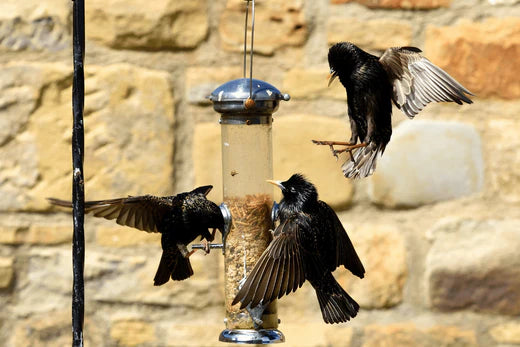


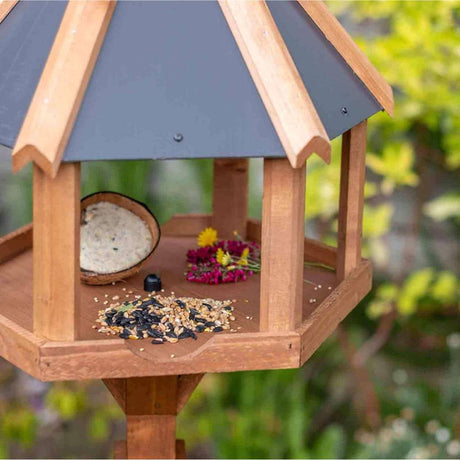

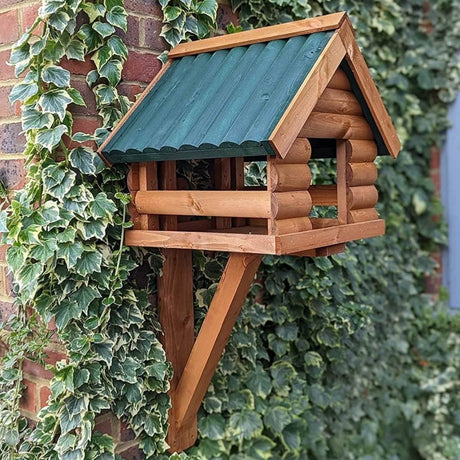
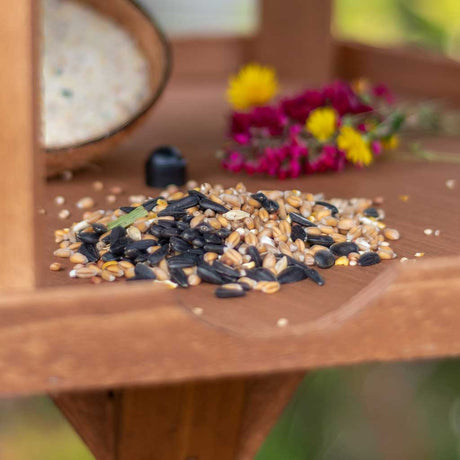
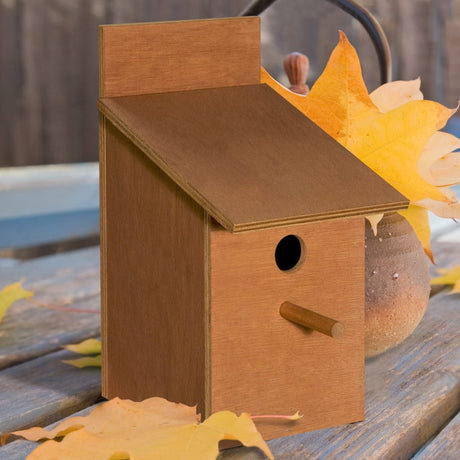

33 comments
Whoever wrote this post is out of touch with the real world ! 80% less ? lol ! A family opposite have this year put lots of bird feeders in their garden which is right next to some large trees which have grown taller in the last few years! Now we have hundreds of starlings nesting in their garden which trees and crapping all over the driveways and cars . It’s becoming so bad and as they are eating berries their poo is red and really difficult to clean off the drive if you don’t do it straight away ! The tree needs to be cut down and hopefully it will as there is a covenant that the trees cannot be higher then 10 feet ! These are double that !
I have starlings nesting in my eaves, when can I block this gap off as they are so noisy in my new build house as the walls are thin, my son cannot sleep, I am happy for them to nest on the end of my three story house as I want my roofer son to put a bird box there for them to nest instead. So I can still see them fly in and out as they are amazing but very very noisy birds 🦅
I am trying to discourage the starlings from ravaging my feeders by using an .22 air rifle. From 20 yards, I seem to be having some success because it looks like fewer and fewer are coming each day. After trying lots of different techniques, I’m fairly convinced this is the best method so far. I only wish I could have as much success with the magpies.
I’m happy to take your word for it that starling numbers are in decline but in comparison to what? There are literally millions flying around so even with 80% decline they massively outnumber other birds.
And yes, I will admit it, I have grown to hate them. I have completely stopped putting mealworms out as they absolutely mob the feeder, squabbling and bullying other, smaller birds. Now they’ve turned their attention to the fat balls!
I don’t care so much about their messy feeding as I have wood pigeons who eat off the ground. My beautiful collared doves have stopped visiting. I honestly didn’t mind feeding all species but these horrible pests are literally driving other birds away.
I now only put out sunflower hearts which the starlings can’t get to because the mesh on the feeder is too small. The tits and finches manage fine though.
I actually call them the mafia. I have 5 window feeder because I love in an apartment. Sorry, but everything in this article above is contradicted by the starlings that luve around me. They start bombing my feeders from 06.30, they’re still hanging around in a huge group, the same lot since winter I think. They bully the smaller birds and even the pigeons. They throw half of the mealworms out of the feeder tray so its wasted and I bought a “small bird” special feeder recently and im constantly having to chase the little sods out of that now. They’re relentless. They’re in and out of the food literally all day until sundown. I enjoy the random quiet moments after work when the small birds DO get chance to feed, but if the mafia don’t stop, if I don’t find a way to get them to stop eating it all, there will be nothing for the small birds because I can’t afford to keep replacing it at the way it’s being wasted by these bully birds
Sorry but this article has not helped convince me at all and I still hate them lol. To solve my starling issue I purchased a large gabion cage with 45 mm holes then wired bamboo strips to the outside to make the gaps around 25mm to 30mm and then I assembled it within the bushes the little birds hang out in leaving the front side only wired at the top so I can open it up like a door then just secured it in place with a few zip ties. Sparrows tits and robins all fit nicely through the bars and can eat inside in peace and the starlings and other bigger birds all just collect what falls through the bottom of the cage. Only bird seed gets placed outside now and any suet or peanuts or fat balls all go inside of the cage. Problem solved 🥳
I have just been told to clean all the poo away as, starlings spread something called Histoplasmosis which is very nasty to dogs and cats. I am scrubbing this weekend!
I have brought a fantastic starling proof Guardian Bird Feeder, from CJ wildlife, for my 2 lonely blue tits who refuse to be bullied.
The starlings have rid my garden of all of my other birds, robins, I have had Robins for years feeding on a window feeder, we consider them friends and got to know them individually, once the starlings came this year, not one have I seen along with Jenny wrens, all the tit family etc. Even the raptors have gone! I am just left with starling poo on my car, windows, outbuildings everywhere, and they raid my feeders, they fight and bring stress into my calm oasis, I am an organic animal loving vegan but I hate starlings. Even the stoic sparrows keep away, the whole village has been taken over by them, will my lovely Robin friends ever return, life is not the same without them, I didn’t realise what effect they had on us until they were evicted.
I’d like to throttle whomever brought these nasty birds to the US from the UK. They’re evil. They come in hordes, decimate the feeders, and nothing seems to deter them. We’re using sunflower seeds because our cardinals, robins, chickadees, sparrows and other native birds like them. But the starlings will go through $20 worth of seeds in a single sitting. Just can’t do it any more. I will try to attract some bluejays; at least when they bully, they do it one on one instead of 200 on one.
I asked google for a starling proof feeder but got this article instead and like others my feeders are being decimated by these birds, I need positive help regarding the feeders.
Totally agree with all this
I AGREE WITH YOU WE LOVE TO WATCH THEM AS YOUSAY FEEDING BABIES JUST WISH THEY WOULD NOT TOSS IT ON THE GROUND A LOT OF MEALWORM IS ON THE GROUND BENEATH THE BIRD FEEDER AND THEY DON’T PICK IT UP FROM MERLYN
Same for me. I have 2 feeders plus 3 fat ball holder and a peanut one. The starlings eat everything. I am not going to fill the feeders for 3 days. I assume my garden birds manage on their own. I just like to give them a helping hand.
I love my starling visitors. Their wonderful chatter and whistling is enchanting. Yes, they are gregarious and raucous but that’s their personality. I have a variety of feeders with different foods. I get wild green parakeets, blue tits, woodpeckers and magpies. What I find is the woodpeckers wait in the tree opposite for the starlings to finish then pop over for their snack. Sometimes I watch the starlings sit on the satellite dish while the blue tits feed on the fat balls. They are not aggressive with the other birds, only each other. So as long as all the birds keep visiting I will happily put out extra food for the starlings. I think a variety of feeders with food starlings are not interested in is the answer. I use seed, fat balls and peanuts. They don’t bother with the seed preferring the fat balls.
It’s good reading all the comments I felt I was the only person having the problem with the starlings ….I like them but they are just so greedy , might try a squirrel proof feeder too to see if it helps ! Thankyou for the article .
I just find it really expensive to feed all the starlings that are turning up.if the food is not there for them ,its like a riot, what id like to know is who does sell the cheapest food?